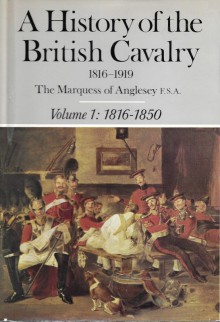
When I was growing up one of the board games I enjoyed playing most was Risk. Part of the game involved a deck of “territory cards” on which, in addition to the color-coded territories depicted on the map, there were silhouettes of Napoleonic-era soldiers and weapons depicting infantry, artillery, and cavalry. While the infantry and artillery were and still are relatable arms to people today, the cavalry seemed much more representative of the forces of a bygone era, with their role both esoteric and archaic.
Yet the cavalry remains a subject of great fascination for many. Among their number was Henry Paget, the seventh Marquess of Anglesey. The descendant of a cavalry commander who served during the Napoleonic wars, Anglesey spent over three decades writing a multi-volume history of the British cavalry from their heyday in the aftermath of the battle of Waterloo to their obsolescence a century later. It is a monumental work in the truest sense of the term, one that details an arm and the men who served in it.
The first volume of Anglesey’s work, which covers the three and a half decades following the Napoleonic wars, is a book of three parts. The first part is an extended prologue that traces the history of the British cavalry from its origins as an elite force of armored knights on horseback to their more specialized employment for reconnaissance and as a strike force in the early modern era. What emerges from these pages is the sense of constant evolution facing the cavalry, as they adjusted to the ever-shifting conditions of war in ways that maintained their usefulness in battle, albeit sometimes in very different roles.
After a chapter summarizing the post-Napoleonic reductions in the cavalry and their employment in domestic police work (a role which became increasingly obsolete with the development of a dedicated police force), Anglesey moves on to the second part of his book, which details the social history of the cavalry. Here he explains in more detail the different types of cavalry, their assigned functions, and the lives of the officers and men who served in their regiments. The life he describes was a hard one, made even more difficult by the penny-pinching of successive peacetime governments. Here he covers as well the composition of the Indian cavalry employed by the British, showing the increasingly imperial composition of the British forces during the era.
Having described the lives of the men who served in the cavalry, Anglesey then shifts his focus to describing the wars of the era in which they served. This forms the final part of his book, and offers a cavalry-centric account of over a half-dozen campaigns waged on the Indian subcontinent. Anglesey’s coverage here is very traditional, often adopting the perspective and tone of the accounts from the era. As with his earlier chapters he describes a service that remained wedded to Napoleonic tactics and methods of training, which while increasingly obsolescent still were adequate for the wars in which the cavalry were employed. As Anglesey concludes, it was only with the challenges that the cavalry would face in the 1850s, that the need for change became obvious.
By the end of the book Anglesey succeeds in demythologizing a force which is too often stereotyped by its caricatures. While somewhat limited in terms of its research and dated in its interpretations, it nonetheless stands as the indispensable starting point for anyone interested in learning about the British cavalry or the post-Napoleonic British army more generally. In terms of the depth of the author’s understanding and his passion for the topic, though, it is unlikely every to be surpassed.

 Log in with Facebook
Log in with Facebook 






